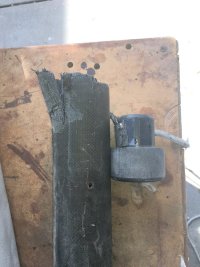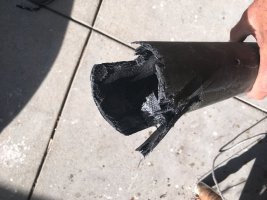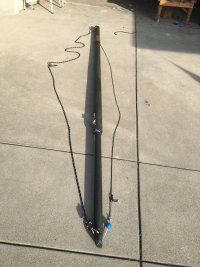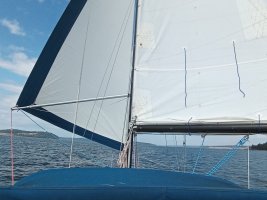My Forespar Line Control carbon fiber whisker pole broke again in 2021, the cause still a mystery to me. Video of the specific pole-break sequence is here. Conditions were gentle 15 knots, there were no fouls, the pole didn't sky. The camera was off at the actual break point, but the recording gap is only a few minutes. The 3 1/2" tube fractured less than three feet from the base. I was able to make a temporary repair, as the video shows, to gain a fixed-length pole of 16', which was adequate for the cruise.
At home, I took the pole apart to clean up the repair of this sophisticated but problematic gear. The "line control" idea is simple: the smaller tube telescopes by being controlled by a 5/16ths control line which is cleated to the outside of the base. The control line runs externally outward, where it meets a sheave in an exit box to enter the larger tube. It then travels internally to the base of the inner tube, where it is secured. Pulling the exterior line draws the smaller tube outward. When the proper length is obtained the line is cleated to the external cleat.
On my prior voyage the control line broke and the small tube violently smashed home, destroying its stop and jamming. Forespar fixed it for free. They revised the pole to eliminate chafe where the line enters for its internal run. The pole worked again as advertised.
This time, as the video shows, the 3 1/2" tube broke at the point where the internal tube rested at its length setting. (In the photo the plug is reversed. It goes the the other way around, fixed to the end of the smaller tube to provide end stability.)

What I did at sea worked: just saw the broken end off, ignore the line control feature, and use screws to fix the pole at one length. At home I cleaned up the work and now have a fixed-length CF pole that is adequate against the strong compression forces formerly handled by the control line.
In fact, I could have returned the pole to its original line control design, albeit three feet shorter overall. It would still have extended to the 18 or 20 feet necessary to wing out a big genoa to the maximum when dead downwind. It would just be a matter of reinstalling the cleat and sheave at the (new, shorter) base end, and running a new internal/external control line.

I chose to give up on the whole line control idea and stick with a fixed-length pole. Why:
As a practical matter, the pole cannot be extended by line control with the sail flying. Too much compression. Also, the pole when mounted on my boat is at head height, creating an awkward reach to a line under considerable strain and cleated to a small plastic cleat. It was just a pain in the butt over the course of 10,000 miles and two voyages. (Height of a horizontal whisker pole depends on height of genoa clew.)
If I do buy a new whisker pole, it will be adjustable in length by some other means--probably the traditional buttons.
The question of the suitability of carbon fiber remains a good one. It is remarkably light (and expensive). It is undeniably strong, but equally fragile. A stay will saw into it readily. It doesn't bend, it fractures violently. It must be painted or protected by a cover, since vulnerable to UV. For a singlehander wrestling to jibe a pole at night on a pitching foredeck, the weight difference between CF and my former telescoping aluminum pole was notable and persuasive. Yet carbon fiber has caused me nothing but trouble despite babying the thing, installing a leather chafe guard, and fanatical attention to potential fouls and personal alertness to procedure.

I conclude that carbon fiber is a grand advance but more suitable for racing than for cruising. That it is unforgiving of mistakes or mistreatment. And that the odds of failure are too high to justify the expense.
I believe that a better scheme for cruisers is an adjustable aluminum pole stored vertically on the mast, with appropriate track, car and control lines. Downwind the whisker pole gets used a lot, and jibed a lot, and although an athlete can certainly handle my free, dinghy-like system, typical crews benefit from heavier gear and traditional handling methods.
But it is nice to now have a fixed length CF pole that weighs, by bathroom-scale test including the bridle, only 11 pounds.

Also indexed as Blog entry.
At home, I took the pole apart to clean up the repair of this sophisticated but problematic gear. The "line control" idea is simple: the smaller tube telescopes by being controlled by a 5/16ths control line which is cleated to the outside of the base. The control line runs externally outward, where it meets a sheave in an exit box to enter the larger tube. It then travels internally to the base of the inner tube, where it is secured. Pulling the exterior line draws the smaller tube outward. When the proper length is obtained the line is cleated to the external cleat.
On my prior voyage the control line broke and the small tube violently smashed home, destroying its stop and jamming. Forespar fixed it for free. They revised the pole to eliminate chafe where the line enters for its internal run. The pole worked again as advertised.
This time, as the video shows, the 3 1/2" tube broke at the point where the internal tube rested at its length setting. (In the photo the plug is reversed. It goes the the other way around, fixed to the end of the smaller tube to provide end stability.)

What I did at sea worked: just saw the broken end off, ignore the line control feature, and use screws to fix the pole at one length. At home I cleaned up the work and now have a fixed-length CF pole that is adequate against the strong compression forces formerly handled by the control line.
In fact, I could have returned the pole to its original line control design, albeit three feet shorter overall. It would still have extended to the 18 or 20 feet necessary to wing out a big genoa to the maximum when dead downwind. It would just be a matter of reinstalling the cleat and sheave at the (new, shorter) base end, and running a new internal/external control line.

I chose to give up on the whole line control idea and stick with a fixed-length pole. Why:
As a practical matter, the pole cannot be extended by line control with the sail flying. Too much compression. Also, the pole when mounted on my boat is at head height, creating an awkward reach to a line under considerable strain and cleated to a small plastic cleat. It was just a pain in the butt over the course of 10,000 miles and two voyages. (Height of a horizontal whisker pole depends on height of genoa clew.)
If I do buy a new whisker pole, it will be adjustable in length by some other means--probably the traditional buttons.
The question of the suitability of carbon fiber remains a good one. It is remarkably light (and expensive). It is undeniably strong, but equally fragile. A stay will saw into it readily. It doesn't bend, it fractures violently. It must be painted or protected by a cover, since vulnerable to UV. For a singlehander wrestling to jibe a pole at night on a pitching foredeck, the weight difference between CF and my former telescoping aluminum pole was notable and persuasive. Yet carbon fiber has caused me nothing but trouble despite babying the thing, installing a leather chafe guard, and fanatical attention to potential fouls and personal alertness to procedure.

I conclude that carbon fiber is a grand advance but more suitable for racing than for cruising. That it is unforgiving of mistakes or mistreatment. And that the odds of failure are too high to justify the expense.
I believe that a better scheme for cruisers is an adjustable aluminum pole stored vertically on the mast, with appropriate track, car and control lines. Downwind the whisker pole gets used a lot, and jibed a lot, and although an athlete can certainly handle my free, dinghy-like system, typical crews benefit from heavier gear and traditional handling methods.
But it is nice to now have a fixed length CF pole that weighs, by bathroom-scale test including the bridle, only 11 pounds.

Also indexed as Blog entry.

